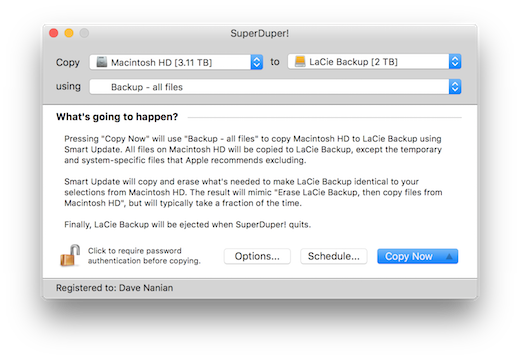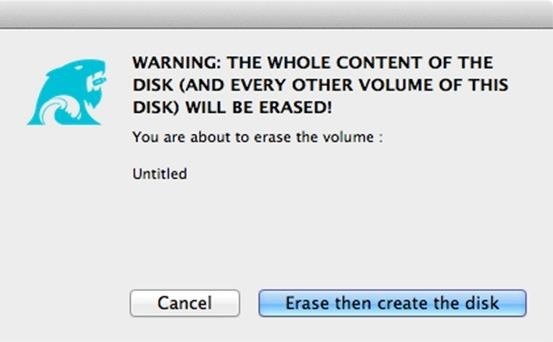Create A Bootable Usb On 10.7.5 For Mavericks
Nov 23, 2016 Create a Bootable USB High Sierra Installer in Mac OS X 10.13 - Duration: 12:53. Gemsbok Apple Tips and Tricks 156,209 views. For those of you who've already gotten Beta Preview or Developer Preview access to Mac OS X 10.10 Yosemite, I highly recommend installing it on a separate partition on your hard drive.
- Create A Bootable Usb On 10.7.5 For Mavericks 8
- Create A Bootable Usb On 10.7.5 For Mavericks Free
- Create A Bootable Usb On 10.7.5 For Mavericks Windows 10
- Create Bootable Usb Mac Mavericks
If your Mac suddenly refuses to boot up properly, you might need a bootable macOS USB installer to make repairs. But how do you create such a disk if all you're left with is a Windows 10 computer? Fortunately, there's a great tool that you can use for free to create bootable macOS media on a USB drive in a Windows 10 environment. This article shows you how to download a macOS DMG file, format a USB drive using a GUID Partition Table, burn the DMG to the drive and boot your Mac from the USB. All the steps except the last one are done on a Windows 10 machine.
Create A Bootable Usb On 10.7.5 For Mavericks 8
May 28, 2018 the existent OS resulted in the birth of version 10.7.5. Apple Mac OSX Lion 10.7.5 Direct DMG Torrent. The version 10.7.5 is here and it is the latest in its domain. An upgradation to the latest version is suggested by the owners of the OS to enable an addition of the latest features unique to this release. That said, if, for whatever reason, you absolutely need to create a bootable install DVD, follow steps 1 through 5 under “Using Disk Utility,” below, but from Step 6 on, follow the. Feb 02, 2021 Create volume name, choose Options GUID Apply. In Lion SharedSupport folder, copy and drag.dmg file to Disk Utility Source. Drag volume to Destination Erase Destination Restore. To boot: Insert flash drive in Mac and restart. Hold Option key while Mac reboots. In OS X Startup Manager, select bootable drive. How to make a bootable usb flash drive to install Panther OS X, Tiger OSX, Leopard OSX, Snow Leopard OSX, Lion OSX, Mountain Lion OSX, Mavericks OSX, Macboo.

Part 1: Download macOS or Mac OS X DMG File
The first step is to get the DMG disk image file for the version of macOS that you want. You can get a copy of the latest macOS version from Apple download portal or App Store here. There are also several other direct download sites that offer various versions of Mac OS X in DMG format rather than the standard APP format that runs on Mac. Since you're working in a Windows environment, you need the DMG rather than the APP file.
macOS DMG Download Link:
Part 2: Easily Create a Bootable macOS USB from Windows 10/8/7 PC
You have now formatted the partition of USB drive. It's time to download UUByte DMG Editor for Windows. Although this is a premium software, you can use the initial free trial period to create a bootable macOS USB on Windows 10. After installing the application, follow the sequence of steps shown below:
Updates (Dec 8, 2020): The latest version of UUByte DMG Editor is able to format the USB automatically.
Step 1: Right-click the software icon on desktop and select 'Run as Administrator' from the contextual menu. Choose 'Run' when prompted.
Step 2: Insert your formatted USB drive, and click 'Burn' tab on the main screen.
Step 3: Click 'Browse' button to import macOS dmg file into the program. And select the USB drive name from the second row. You can also set a volume labe for that USB drive.
Step 4: Click 'Burn' button at the bottom to start the process. You will see a progress bar and wait around 10 minutes to get it done.
Step 5: Once the progress bar is at 100%, a bootable macOS USB is ready. After that, you can use that USB drive for installing macOS.
This is one of the easiest way to create a bootable macOS USB on a Windows PC. The steps are simple and instructions are pretty clear.
Part 3: Format USB Drive to GPT If Failed
If the USB drive created in above step was not seen as a bootable device on your Mac, then you need to take an addtional step before burning. That's formatting the USB to GPT.
Mostly, the USB drive was formmated to FAT32 in default when being shipped out from the factory. However, FAT32 can be only used for installing OS with legacy BISO, which doesn't work for macOS. So the next step is to format your USB drive in the GPT partition style in order to burn installation files to the desired USB drive. You can do this in Command Prompt as admin. In elevated Command Prompt (Ctrl+Shift+Enter), input the following series of commands followed by Enter after each line:
Diskpart
List disk
Select Disk X (X stands for the USB drive name that appears after the previous command)
Clean
Convert GPT
Create partition primary
Part 4: Boot Mac from macOS USB Drive for Installation
Now remove the USB drive and insert it into the Mac computer. To boot from the disk, you need to hold down the option key when you hear the boot chime. This will take you to the Startup Disk Manager, where you should be able to see the USB drive. It might have a different name, but as long as it is bootable, you'll be able to see it there. Once you select it, the computer will boot from the disk and the macOS installation will begin.
Troubleshooting
Flashing Error: You might receive a flashing error message at the end of burning process. Please don'y worry and ignore this error. The USB becomes a bootable disk and you can use it to install macOS even this error pops up.
About Official EI Capitan DMG: There has a serious bug in the official release of OS X El Capitan, which contains .pkg installer only. The burning process will fail for sure. Please use this modified EI Capitan DMG file instead, which was approved a good option.
Registration Failed: Please make sure the computer is connected to Internet and no proxy or VPB is running during registration. If the problem still exists, please send an email to support team asking for a new code.
Conclusion
The whole process might look a bit complicated if this is your first time, but just follow the instructions in this article and you should be fine. That being said, you need to be careful when downloading the DMG file and formatting your USB drive. If you don't do these two steps correctly, the output drive from the UUByte DMG Editor software won't be bootable, which means you can't install macOS from that USB drive, and you may need to do the whole thing over again.
This guide deals with 3 ways of making a boot disk from macOS, the first one is the fastest and is done via the Terminal from a command in macOS called createinstallmedia, the other 2 are older ways are done with a mixture of finder using Disk Utility and command line.
The first way can support macOS Big Sur, macOS Catalina, macOS Mojave or macOS High Sierraand further back to SIerra, El Capitan, Yosemite and Mavericks.
Quickest Way
Download the macOS version you need but don’t install.
Attach your USB stick/drive.
Launch the Terminal from /Applications/Utilities and enter the command below and then your password when prompted, be sure to change the ‘Untitled‘ name in the below command to your external disk name:
Create A Bootable Usb On 10.7.5 For Mavericks Free
Let it do its thing and there you have it, one bootable macOS drive.
This really is a super simple way – however if using the Terminal fills you with fear and dread, there are some GUI apps that can get the job done namely DiskMakerX and a new imaging tool that can clone a new disk very quickly – AutoDMG, although AutoDMG can not work with macOS Big Sur
Alternative Ways of building a Bootable macOS Disk.
An alternative way to make a boot disk of macOS (but not macOS Big Sur), first of all, get the app or download via the App store, if downloaded it will file in the folder Applications.
The example below uses OSX Mavericks.
Control / Left click Options, Show in Finder to get to the app, don’t install at this stage.
Located in the Applications Folder
Finding the InstallESD.dmg
To find the actual InstallESD.dmg file, control/left click the ‘Install macOS’ app and choose show contents – then navigate to Shared Support folder.
Control/Right click to show contents
Navigate to Shared Support folder to see the InstallESD.dmg file
Mount InstallESD.dmg
Double click to mount the image.
Make Invisible Files Visible
We need to see the BaseSystem.dmg inside the InstallESD.dmg
Crank open Terminal and run:
This will show all invisible files have a look inside the mounted InstallESD.dmg
Mount an External Disk
Attach a USB/external drive – this guide uses the external drive name called BootDisk, you need to make sure the format is correct, it needs to be Mac OSX Extended Journaled – if it’s not you can format that in Disk Utility.
Launch Disk Utility
Launch Disk Utility as found in Applications/Utilities and go to the Restore tab.
Drag BaseSystem.dmg to the Source field and your external disk to the Destination and click Restore.
This will mount your new macOS external disk and name it OSX Base System – but we need to add the packages.
Fix the Packages
Couple of things to fix in the newly created boot disk, remove the Packagealias at System/Installation/ folder
Now from the previously mounted InstallESD.dmg copy over the Packages folder to the same location where we just removed the alias above.

Will take a while as it holds all the install packages.
Job done now you can boot from the OSX 10.9 disk.
Make the Visible back to Invisible
If you want all to return back to normal and hide the system files run a couple more commands in the Terminal
How to create the OSX 10.9 Mavericks Bootable Drive just via Terminal
Just for the crazy ones……after Mavericks is downloaded….and again this assumes you external disk is named BootDisk
Mount the InstallESD.dmg buried deep in the app
Swap to the newly mounted image

This puts you back in the Finder in front of the newly mounted InstallESD.dmg, go back to Terminal and clone the BaseSystem.dmg to the remote USB drive
This will change ‘BootDisk‘ to ‘OS X Base System‘
Remove the existing Packages alias link from the newly restored image
Copy the full OSX Mavericks Packages over to the new image….takes a while

Create A Bootable Usb On 10.7.5 For Mavericks Windows 10
And there it is! – to eject the new bootable USB OSX Mavericks 10.9 disk ‘cd’ to home and eject
Create Bootable Usb Mac Mavericks
Now you can boot up from your newly bootable disk and either Install OSX10.9 on another device or use the Terminal/Disk Utility or Firmware Password Utilities on another device.